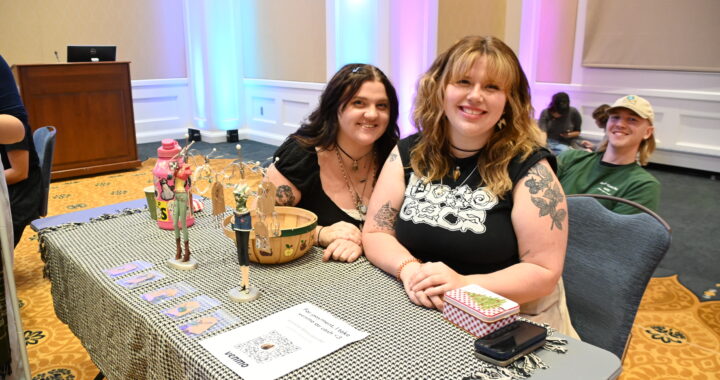How to care for your pet: hermit crabs
4 min readLocal pet store customer Candise Larner admitted that she purchased hermit crabs before knowing exactly what the pet’s care and maintenance entailed.
However, after speaking with a knowledgeable pet store employee and doing some at home research, Larner said she was able to care for the creatures properly.
There are many different types of hermit crabs available in the pet trade. One of the most common breeds is the West Atlantic hermit crab, more widely known as the Purple Pincher.
Hermits live in empty snail shells and must locate and acquire these shells each time they grow larger.
Adult hermit crabs are nocturnal while younger, smaller crabs are more active during the day. They can live to be about ten years old and grow to be three to six inches long.
Hermit crabs should have their substrate humidity maintained between sixty and eighty percent. Sand is seen as the most natural choice, but it needs to be kept at “sand castle” consistency to maintain the humidity level.
Organic potting soil that is kept lightly moistened and is thoroughly mixed on a regular basis is another option. It holds water much better than sand and the hermits are able to burrow into it like sand.
Other substrates that can be used include ground coconut husk and moistened cyprus bark depending on crab size. Hermits love to burrow, so a few inches of substrate should be provided and replaced at least once a month.
Fresh water should be available at all times in a crab’s enclosure.
Water that comes in contact with a hermit crab should be treated with a standard water dechloronator.
The water set up should consist of a shallow dish with a sponge so that food and water is accessible.
Hermit crabs need to be bathed at least twice a week in a salt-water solution, which acts like Gatorade and provides electrolytes. Water wets their gills and refreshes the water that the hermits keep in their shell. A regular bath can also help to dislodge sand particles inside the shell.
“My hermit crabs are awesome. My favorite thing about them is how they change shells so I have to guess which one they’re in all the time,” said Larner. “I also love taking them out to play and giving them a bath. They are so easy to take care of.”
Hermit crabs can tolerate a range of temperatures from 70 F to 82 F, but they are much more active and healthy if the temperatures are 76 F to 82 F.
Using a reptile heat lamp, heating bulb, or even a small table lamp will help achieve higher temperatures in the crab’s enclosure.
A red or dark blue or purple bulb will mimic moonlight and the hermit crab can be more active. A white bulb will need to be shut off at night to give a crab a proper day and night cycle.
If the heating element needs to be kept on all the time to maintain proper temperatures, using the color bulbs is more practical.
At least one thermometer and one hygrometer should be included in the enclosure.
Knowing the warmest temperature in the enclosure and the humidity percentage will determine if the crab’s environmental requirements are met and whether adjustments need to be made.
The most popular choice for an enclosure is the glass aquarium. A minimum enclosure size is a 10-gallon tank, which supports a maximum of four medium to large hermit crabs.
A less expensive enclosure alternative is a rubber maid container. People can also build their own as long as the enclosure choice is the same size and the structure is modified for ventilation and lighting.
“We have a play yard for them so they can come out to play outside of the tank,” said local pet store customer Jennifer Grim. “They are so easy to handle, don’t bite, and stay pretty clean for the most part. My 10 year old son has them because they are so easy to take care of, once you know what to do for them.”
Hermit crabs are omnivorous and have a great sense of smell. They have very small guts and can only eat small portions of food at a time.
Commercial food powder should be given as a staple and made available at all times in the enclosure. Pelleted diets can be difficult for smaller crabs to eat.
There is a vast array of other food they are able to eat. Examples of meat include feeder insects, tuna in water, and brine shrimp. Plant options include squash, carrot, and apple.
Using freeze-dried foods in place of live foods is recommended. Hermit crabs are scavengers, not predators.
Collard green, escarole, water cress, or dandelion green should be given with every feeding, as they have high vitamin and mineral contents.
All food items should be finely shredded and tough skins and seeds removed.
Hermit crabs require lots of calcium after a molt in order to harden their exoskeleton.
Plain calcium powder with no vitamin D3 added that can found in any reptile section of a pet specialty store is adequate.
Other sources of calcium include powdered milk, cuttle bones and crushed oyster shell.
Molting is the shedding of the hermit’s skin or exoskeleton. A crab’s exoskeleton is rigid and not flexible, so hermits molt when they need to grow larger.
The hermit will shed the old soft skin, engorge on water to become physically larger, and then the outer skin will harden again.
The entire molting process usually takes three to four weeks.
Younger, smaller hermits will shed more often, and larger older hermits will shed less often.
The hermit crab consumes the molted exoskeleton during the molting process and should not be disturbed during the process.


